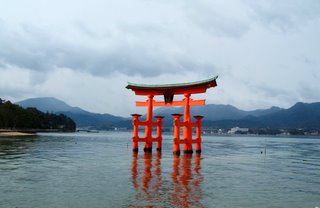
Midway through our memorial visit to Hiroshima, we ventured out on a much needed one-day excursion to Miyajima, located about an hour beyond the city by train. We hopped aboard one of the many streetcars around eleven am, en route to the nearest train station. Unlike many of the subways, trains, and busses I’ve taken, which typically seem fairly new, the streetcars looked as though they had been in operation since the city’s post-war reconstruction. Thick, riveted, ironclad exteriors, nicely painted and very clean inside, the cars rumbled down the tracks laid down middle of the street. Glancing below at the very large slabs of chiseled granite used to house the tracks, I wouldn’t be at all surprised to learn that they were the originals put emplace a century ago. Had the cars not been weighed down by their heavy frames, it would seem as though they’d be doomed to derailing as they leaned from side to side, noisily down the track, reminiscent of the trolleys that screech along the streets of San Francisco.
As we made our way down the track, I caught my fist glimpse of the Atomic Bomb Dome, a visible skeleton that brings to mind all the souls that were doomed there sixty years before. An eerie silence enveloped my psyche as we passed by, despite business carrying on as usual around me. I really wasn’t ready to see it yet. We passed over the river, along the reconstructed bridge that was the intended as the target of the bomb, which didn’t actually land but detonated 600 meters above to ensure the utmost devastation.
Creaking down the road, we were soon out of the city, traveling on much smoother rails with views of the mountainside and several small orchards to the west with the bay to the east. The day was cold and windy with the sun breaking through the clouds from time-to-time. We disembarked at the ferry station and browsed around the gift shop- nothing special though. As in America, if you been to one, you’ve been to a thousand. Vendors were attempting to entice passersby with samples of octopus tentacles on a stick, similar to corndogs, I guess, which I politely declined.
The ferryboat arrived, slightly surprising me by its small size. It may have been able to hold six cars or so but was nothing compared to the ones I used to take across Puget Sound.
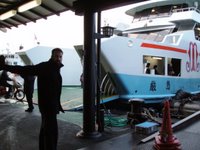 Not surprisingly, the same number of people were onboard this one as the ones in Seattle. Occasionally, I’m still amused by the miniature versions of things I’m used to back home, i.e., tiny vacuums, kitchen appliances, itsy-mini vans, and garbage trucks not much bigger than the Lincoln Navigator. That’s not to say everything in Japan is small, however. In fact, sometimes the size ratio of trucks to cars, barreling down the road, through red lights and while alternating between slamming on the breaks and slamming the accelerator, can be enough to dissuade anyone from obtaining an international driver’s license.
Not surprisingly, the same number of people were onboard this one as the ones in Seattle. Occasionally, I’m still amused by the miniature versions of things I’m used to back home, i.e., tiny vacuums, kitchen appliances, itsy-mini vans, and garbage trucks not much bigger than the Lincoln Navigator. That’s not to say everything in Japan is small, however. In fact, sometimes the size ratio of trucks to cars, barreling down the road, through red lights and while alternating between slamming on the breaks and slamming the accelerator, can be enough to dissuade anyone from obtaining an international driver’s license.We approached the Itsukushima Island, with the blazing orange gate in the foreground- a spectacular site. As with all Shinto shrines, the gate signals the primary entry, only this one, as well as the shrine itself,
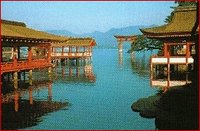 was built over the bay so when the tide comes in, it appears as though floating above the sea. The motivation to build it in such as way is unclear; some speculate it was built to honor the goddess of the sea while others have guessed that it represents the Buddhist belief that the soul crosses into the afterlife by boat. Whatever the case, it is a beautiful structure. Due to its unique design and significant age of nearly 1400 years, it is designated as a World Heritage Site. We decided to forego the tour and avoid the crowds, instead viewing it from afar.
was built over the bay so when the tide comes in, it appears as though floating above the sea. The motivation to build it in such as way is unclear; some speculate it was built to honor the goddess of the sea while others have guessed that it represents the Buddhist belief that the soul crosses into the afterlife by boat. Whatever the case, it is a beautiful structure. Due to its unique design and significant age of nearly 1400 years, it is designated as a World Heritage Site. We decided to forego the tour and avoid the crowds, instead viewing it from afar.On the hillside above, sits Senjokaku, known as shrine of “1000 mats” due to the great number of tatami that it would take to cover the floors. Built around the same time as Itsukishima Shrine,
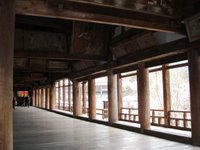 it was never actually completed. Inside the dimness were a great number of paintings depicting religious scenes, brushed on slabs of wood. Numerous wooden rice spatulas, some of which were as long as a dining room table, others used as canvasses, were displayed, apparently representative of one of the many Shinto gods. My grandparents used to have immaculately painted statutes of this and other Shinto gods displayed in the china cabinet; they have since been handed down to my Auntie.
it was never actually completed. Inside the dimness were a great number of paintings depicting religious scenes, brushed on slabs of wood. Numerous wooden rice spatulas, some of which were as long as a dining room table, others used as canvasses, were displayed, apparently representative of one of the many Shinto gods. My grandparents used to have immaculately painted statutes of this and other Shinto gods displayed in the china cabinet; they have since been handed down to my Auntie.Next to Senjokaku is a five story pagoda, brilliantly painted in bright fiery orange over white panels. I’m guessing the age of the pagoda is similar to the shrines. Modeled after Chinese designs, it rests atop the hill as if it were a crown.
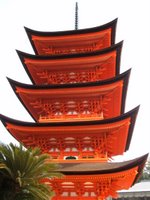 Though we were not able to access the inside, it supposedly contains well preserved paintings of natural scenes along with dragons and phoenixes. Originally, there were religious images displayed on the outer pillars but have since been relocated after syncretizing Buddhism and Shintoism became forbidden.
Though we were not able to access the inside, it supposedly contains well preserved paintings of natural scenes along with dragons and phoenixes. Originally, there were religious images displayed on the outer pillars but have since been relocated after syncretizing Buddhism and Shintoism became forbidden. We then walked down to the village and browsed around the shops. We came across some amazing traditional wooden carvings,
We then walked down to the village and browsed around the shops. We came across some amazing traditional wooden carvings, 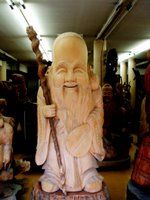 some being larger than life, with intricate depictions of Buddhist themes. In a few of the shops there were no staff present- not that anyone could easily walk off the island with an 8 foot Buddha hoisted over their shoulder; it was just out of the ordinary. We did manage to go into one shop that was staffed where I left with a little hand drum for my godson, Zayne.
some being larger than life, with intricate depictions of Buddhist themes. In a few of the shops there were no staff present- not that anyone could easily walk off the island with an 8 foot Buddha hoisted over their shoulder; it was just out of the ordinary. We did manage to go into one shop that was staffed where I left with a little hand drum for my godson, Zayne. Because the island is scared, there is a prohibition against dislodging rocks (perhaps selectively),
Because the island is scared, there is a prohibition against dislodging rocks (perhaps selectively), 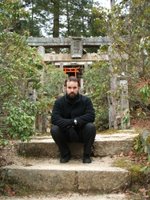 thereby protecting the island from becom- ing developed thus, preserving its natural beauty. Beyond the shops is Momijidani Park, a quiet and peaceful place to enjoy creation. There are several small waterfalls with bridges connecting paths to the gondola at the foot of the mountains that leads to the top of the mountain.
thereby protecting the island from becom- ing developed thus, preserving its natural beauty. Beyond the shops is Momijidani Park, a quiet and peaceful place to enjoy creation. There are several small waterfalls with bridges connecting paths to the gondola at the foot of the mountains that leads to the top of the mountain. As the ropeway crept in elevation, we could see the entire inlet in the distance, and snow slowly began to fall. The ride to the top took around twenty minutes. When we arrived, there were large packs of monkeys huddled together, trying to keep warm and dear moseying at a comfortable distance nearby. Signs were posted, requesting people not to feed the animals but to keep them wild,
As the ropeway crept in elevation, we could see the entire inlet in the distance, and snow slowly began to fall. The ride to the top took around twenty minutes. When we arrived, there were large packs of monkeys huddled together, trying to keep warm and dear moseying at a comfortable distance nearby. Signs were posted, requesting people not to feed the animals but to keep them wild, 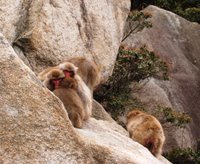 which I think were adhered to by the way they distanced themselves from the tourists (a good thing, in my opinion). Few people ventured up there that day, a nice change from the typically claustrophobic popular destinations. From the top, we could see for miles. It was a spectacular view- the best I’ve seen yet.
which I think were adhered to by the way they distanced themselves from the tourists (a good thing, in my opinion). Few people ventured up there that day, a nice change from the typically claustrophobic popular destinations. From the top, we could see for miles. It was a spectacular view- the best I’ve seen yet.We made our way back down the mountain shortly after taking in the view from above. On the way back to the ferry, we stopped in the village and had lunch. The streets were more populated and not unlike most tourist areas I’ve visited anywhere else. The main attraction was fresh oysters, cooked over open flame grills and served with lemon. I don’t know that I’d ever tried one prior, but I decided to indulge and was pleasantly surprised. I don’t think I’d be up to eating them any other way. Afterward we made our way back to across the bay only this time, we happened to arrive at the terminal just in time to hop aboard a brand spanking new train providing for a smooth ride back into the city.
Hiroshima should be obligatory for the itinerary of every American who visits Japan. That stated, I highly recommend that those doing so include an afternoon in Miyajima, if for nothing else than to attain some solitude.

No comments:
Post a Comment